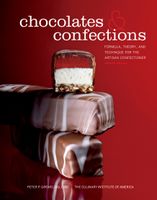Label
All
0
Clear all filters
Save 25% on ckbk Premium Membership with code FALLFLAVORS 🍁
Technique: Classic Nougat
Appears in
By Peter Greweling and Culinary Institute of America
Published 2007
The method for classic nougat Montelimar or torrone differs slightly from the basic albumen method. Rather than cooking all of the sugars together and adding them to the whipping albumen, the sugars are cooked in two separate batches: the first contains only the honey and is cooked to a relatively low temperature (approximately 120°C/248°F). This low-cooked honey is added to the already whipping albumen and both are whipped to aerate and stabilize the foam. This step is identical to making an Italian meringue in a pastry kitchen. After thoroughly aerating the albumen and the low-cooked honey mixture, a second batch of sugar—consisting of the sugar and glucose syrup—is cooked. This batch is cooked to a higher temperature, ranging from 130° to 155°C/266° to 311°F, depending on the desired firmness of the finished product. The higher the temperature the sugars reach, the less water they contain, and the harder the nougat will be. The high-cooked sugar is then streamed into the whipping albumen-honey mixture, and the resulting nougat mixture is whipped until it begins to cool. After whipping, an optional ingredient like fondant or confectioners’ sugar may be added to induce crystallization, resulting in a short texture. A fat such as cocoa butter is usually added to shorten the texture of the nougat, and inclusions (toasted nuts and dried or candied fruit) are mixed in.
Become a Premium Member to access this page
Unlimited, ad-free access to hundreds of the world’s best cookbooks
Over 160,000 recipes with thousands more added every month
Recommended by leading chefs and food writers
Powerful search filters to match your tastes
Create collections and add reviews or private notes to any recipe
Swipe to browse each cookbook from cover-to-cover
Manage your subscription via the My Membership page
Monthly plan
Annual plan
Part of
Advertisement
Related Recipes
-
-
-
-
Related Reference
-
-
-
-
Advertisement
The licensor does not allow printing of this title




